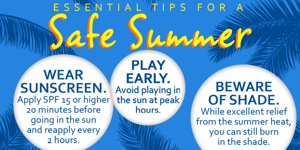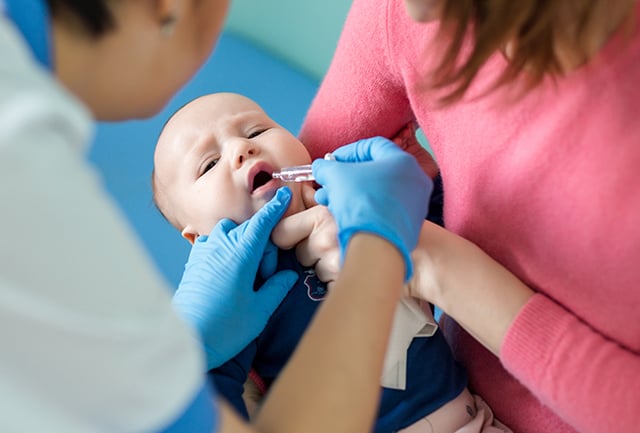
Summer time is here and so are the endless hours of outdoor fun. While you’re enjoying the sun with your family, you will want to keep in mind the safety tips below. These tips have been adapted from HealthyChildren.org, an online parent resource from the American Academy of Pediatrics.
What's the best way to protect my child in the sun?
These simple rules will help protect your family from sunburns now and from skin cancer later.
- Keep babies younger than 6 months out of direct sunlight. Find shade under a tree, umbrella, or the stroller canopy.
- When possible, dress yourself and your children in cool, comfortable clothing that covers the body, like lightweight cotton pants, long-sleeve shirts, and hats.
- Select clothes made with a tight weave - they protect better than clothes with a looser weave. If you’re not sure how tight a fabric’s weave is, hold it up to see how much light shines through. The less light, the better.
- Wear a hat or cap with a brim that faces forward to shield the face.
- Limit your sun exposure between 10 a.m. and 4 p.m., when UV rays are strongest.
- Wear sunglasses with at least 99 percent UV protection (look for child-sized sunglasses with UV protection for your child).
- Use sunscreen.
- Set a good example. You can be the best teacher by practicing sun protection yourself. Teach all members of your family how to protect their skin and eyes.
Sunscreen
Sunscreen can help protect the skin from sunburn and some skin cancers, but only if used correctly. Sunscreen should be used for sun protection, not as a reason to stay in the sun longer.
How to Pick Sunscreen
- Use a sunscreen that says “broad-spectrum” on the label - that means it will screen out both UVB and UVA rays.
- Use a sunscreen with an SPF (sun protection factor) of at least 15. The higher the SPF, the more UVB protection the sunscreen has.
- Look for the new UVA “star” rating system on the label.
- One star is low UVA protection.
- Two stars is medium protection.
- Three stars is high protection.
- Four stars is the highest UVA protection available in an over-the-counter sunscreen product.
- For sensitive areas of the body, such as the nose, cheeks, tops of the ears, and the shoulders, choose a sunscreen or sunblock with zinc oxide or titanium dioxide. While these products usually stay visible on the skin even after you rub them in, some now come in fun colors that kids enjoy.
Sunscreen for Babies
- For babies younger than 6 months: Use sunscreen on small areas of the body, such as the face and the backs of the hands, if protective clothing and shade are not available.
- For babies older than 6 months: Apply to all areas of the body, but be careful around the eyes. If your baby rubs sunscreen into her eyes, wipe the eyes and hands clean with a damp cloth. If the sunscreen irritates her skin, try a different brand or try a sunscreen stick or sunscreen or sunblock with titanium dioxide or zinc oxide. If a rash develops, talk with your child’s doctor.
How to Apply Sunscreen
- Use enough sunscreen to cover all exposed areas, especially the face, nose, ears, feet, and hands and even the backs of the knees. Rub it in well.
- Apply sunscreen 15 to 30 minutes before going outdoors to give time for the sunscreen to bind and absorb into to the skin.
- Use sunscreen any time you or your child might sunburn. Remember that you can get sunburn even on cloudy days. Also, UV rays can bounce back from water, sand, snow, and concrete so make sure you’re protected.
- Reapply sunscreen every two hours. Sunscreen wears off after swimming, sweating, or just from soaking into the skin.
For more summer safety information tips, visit HealthyChildren.org.





